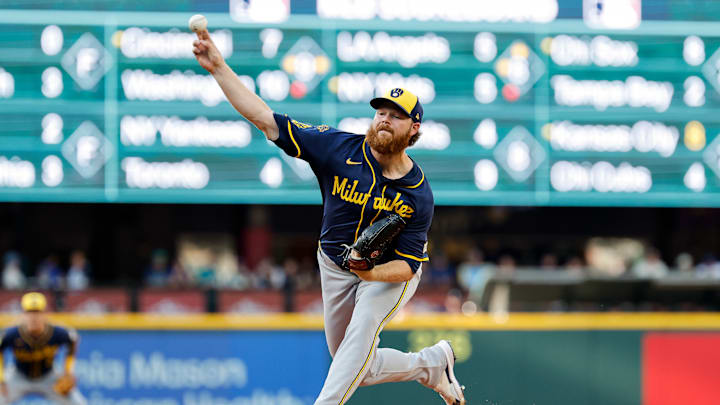Brandon Woodruff’s return to the Milwaukee Brewers after almost two years on the shelf has been better than almost anyone could have anticipated. It’s a minuscule sample, but in three starts in 2025, Woodruff has allowed just three runs for a 1.65 ERA and the Brewers have won all three of his starts.
But after so much time off, Woodruff is not the same pitcher that he once was. Through three starts, Woody's efficiency has been better than ever. Woodruff is averaging just 13 pitches per inning, which is the lowest number of his career by a significant margin — his previous career low was 15.6 pitches per inning in the 67 pitches he threw in 2023. Is this a legitimately new approach, or is it just a product of a small sample that will even out as we move forward?
A change in velocity
First, a caveat—Woodruff hasn’t gotten beat up yet, and it doesn’t take long for a couple of bad outings to swing that average number up quite a bit. Don’t expect Woodruff to maintain a 1.65 ERA for the rest of the season, so his average number of pitches will surely rise a bit once he runs into some trouble.
But it’s not unreasonable to think that Woodruff has altered his approach as he gets used to his new reality. Woodruff is 32 years old now, and his fastball velocity through three starts is averaging just 92.7 mph, which is not only in the bottom quarter of the league, but it’s significantly below where he was throwing before his shoulder injury. In Woodruff’s best season in 2021 (when he was at the “peak” age of 28), Woodruff averaged 96.4 mph on his fastball, almost four mph faster than where he is in 2025.
It is still reasonable to think that Woodruff’s velocity will improve. In both his first start against the Marlins on July 6 and his last against the Mariners on July 21, Woodruff worked into the game a bit, with a fastball in the low 90s in the first inning that warmed up to the mid-90s by the time he was taken out of the game. In the Marlins game, he struck out Connor Norby with a 95.6 mph fastball to end the fifth inning after starting the game around 92. Against the Mariners, his first few fastballs were 90-91, but by the end of his outing in the sixth inning, he was hitting 96.
A strike-throwing machine
Even if he does regain some velocity, though, Woodruff is pitching differently. In 2025, Woodruff has thrown 71.4% of his pitches for strikes, which is, again, higher than in any other season in his career; his previous high was 68.3% in 2021 (which, as a reminder, was his best season). More strikes means more efficiency.
We tend to associate higher efficiency with pitching to contact, which makes sense; think about Greg Maddux in the 1990s as a guy who didn’t strike everyone out but rarely allowed hard contact. By pounding the strike zone with pitches that are hard to square up, that type of pitcher survives deep into games while avoiding damage. There’s a reason the complete-game shutout on fewer than 100 pitches is called the “Maddux.”
Curiously, Woodruff isn’t striking out fewer batters. In fact, his mark of 12.7 strikeouts per nine innings is the best of his career, a strikeout-and-a-half better than his career high of 11.2 in 2022. Big strikeout pitchers, in contrast to pitch-to-contact guys like Maddux, tend to throw a lot of pitches. Nolan Ryan struck out a million batters, but he walked a half-million as he attacked the edges of the zone and tried to get guys to chase a big curveball.
Right now, Woodruff is showcasing the best of all worlds. He’s striking out more batters than ever, and he astonishingly hasn’t walked a batter yet through three starts. He’s giving up only five hits per nine innings and keeping batters off base (to the tune of a 0.551 WHIP, which—while unsustainable—is crazy; Pedro Martínez holds the record for a starting pitcher at 0.737 in his legendary 2000 season).
Things aren’t going to stay like this for Woodruff. Two of his starts were against sub-par offenses in the Marlins and Nationals, and the other came in the pitcher’s paradise of T-Mobile Park in Seattle. But right now, this version of Woodruff seems to be pitching more to contact by attacking the strike zone. Even if the road gets bumpier, that should lead to increased contact. As long as that contact isn’t damaging (it’s a blip in his tiny sample, but Woodruff has allowed three home runs so far this season, which is at least a little concerning), it should allow Woodruff to keep being effective as he gets used to his new arsenal.
